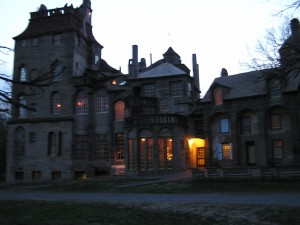Fonthill A Tribute To Mercer’s Eccentric Genius
Approach Fonthill on a gloomy afternoon in late March and you can easily imagine Jane Austen or one of her heroines opening the large, heavy front door, dressed in a gray cloak and headed out to consummate another doomed love affair.
Approach the foreboding Gothic structure in the dark shadows of twilight and your imagination is more likely to picture Barnabas Collins or Vincent Price answering the bell, and all of a sudden your imaginary novel takes on a bit more, um, bite.

Fonthill can appear foreboding in the late-day sun but the interior is surprisingly warm and inviting.
But while there is a room in Fonthill called “the Crypt,” there are no ghosts or things that go bump in the night, except for the occasional tourist trying to negotiate one of the numerous often-narrow, always winding concrete staircases and hallways that connect the various sections of the sprawling home.
Fonthill, a lasting tribute to the fine line between genius and insanity, was the home of the brilliant and eccentric Henry Chapman Mercer, creator and founder of the neighboring Moravian Tile Works and the Mercer Museum, which is located just a mile south of his home. Fonthill staffers prefer “unique” to eccentric, but there is little doubt that Mercer marched to his own drummer.
Mercer graduated from the University of Pennsylvania with a law degree but never practiced law. He was an amateur anthropologist, one of the most-respected artisans of his time and a visionary who recognized the changing face of America and dedicated his life to protecting the legacy of its craftsmen, artists and builders. He spent 10 years touring Europe, courtesy of a rich aunt, and returned home with a passion for castles that was ultimately reflected in his buildings.
Mercer constructed his American castle between 1908 and 1912 and it has 44 rooms, 32 staircases, 18 official fireplaces, 21 chimneys and 200 windows of various shapes and sizes. There is a 19th chimney in the Crypt but it was an experiment and never used, and three of the chimneys are used to dissipate the heat from the home. In keeping with the era, he equipped it with central heat and steam radiators, a call system and intercom phone system so that he and guests could reach the servants at any hour, 10 bathrooms but only five bedrooms.
When Mercer bought the 70-acre property on the edge of Doylestown, it included a farmhouse that dated to the early 1800s. Loath to destroy anything, Mercer simply encased the structure in concrete and made it part of his castle. Visitors who get to the basement can see the original foundation of the farmhouse as well as a fireplace that sits in the middle of a two-story kitchen – evidence of where Mercer had taken out the original first floor and built his own kitchen below that.
“Extraordinary,” said Debra Quinn of Yardley, who participated in the spring version of the semi-annual “Behind the Scenes” tour in late March. “Extraordinary is the only word to describe it. His work, his tiles are just amazing.”
The tour takes in many of the rooms not included in the regular visitations, including Mercer’s Bow Room, Bedroom, Morning Room, Breakfast Room and Smoking Room.

Two young visitors examine the intricate tiles laid into the fireplace in Fonthill's Saloon room. Photo courtesy of Gayle Shupack/Fonthill.
The house was designed to be a showcase for his famous tiles and they are embedded in the concrete walls, floors and vaulted ceilings that give the interior its castle-like feel. Mercer built his castle without blueprints, instead creating scale models that he stacked alongside or on top of others to give his workmen the concept of what he wanted. “That’s why there are so many stairs and hallways going in different directions,” said guide Joe Ciccarelli, who cites the ornate fireplace in the Morning Room as his favorite.
His contracting crew, which consisted of 10 men totally inexperienced in concrete work – he didn’t want someone telling him what couldn’t be done – and a horse named Lucy used to pulley the heavy building material to the upper levels as they were built, created a masterpiece in American architecture.
Mercer began with the Crypt and basement, which is where he experimented with various styles of support pillars and their caps, built the mock fireplace and crafted his own way of building the vaulted arches that symbolize the home, which still houses about 900 prints, 6,000 books and countless tiles Mercer collected from around the world. He lived in the home from its completion until his death in 1930.
Thirteen-year-old Shawn Kelly of Penndel, who joined the Behind the Scenes tour with his father, Steve and family friend Gina Sabella, expressed continuing amazement as the group moved from one room to the next.
“It was all neat! I really liked the Morning Room, that was really neat,” he said. “I want to see the real tour soon.”
If You Go: Fonthill, E. Court Street and Route 313, Doylestown, is open from 10 a.m. to 5 p.m. Monday to Saturday and noon to 5 p.m. Sundays. The last tour starts at 4 p.m. Admission is $7 for adults; $6 for seniors age 62 or older and $4 for children 5-12. Children under 5 are free.
What To Know: Fonthill has many steep, narrow and often uneven stairways and hallways so if you have trouble negotiating these obstacles, you may want to take a pass on the full tour.
Facts: Henry Mercer’s will left Fonthill to the Bucks County Historical Society with the caveat that his housekeeper, Laura Swain, could live there until her death, which occurred in 1970. Swain was said to give impromptu tours to unexpected visitors willing to offer a nice tip.







